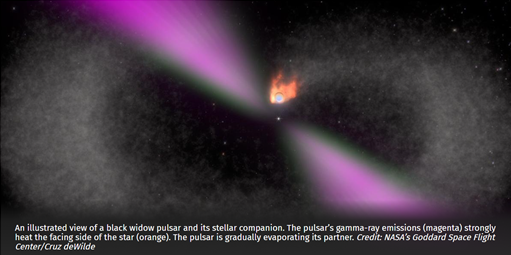

7th May 2022 (7 Topics)
Context
Scientists have discovered a rare "triple black widow" system -- a pair of stars that rapidly circle each other before one is consumed by the other -- located some 3,000 light-years away.
About
About new discovery:
- A black widow binary is a unique system that consists of a pulsar that is circling and slowly consuming a smaller companion star.
- Astronauts have previously identified about two dozen black widow binaries in the Milky Way galaxy but the newest candidate has the shortest orbital period yet identified.
- Named ZTF J1406+1222, the system has a pulsar and a companion star that circle each other every 62 minutes.
- The system derives its name from the "black widow" spiders, in which the female eats the male after mating.
- Another thing that makes the system unique apart from the short orbital period is the fact that it seems to host a third far-flung star that orbits the other two every 10,000 years.
- The study used HiPERCAM, a high-speed camera developed by researchers at the University of Sheffield that can take more than 1,000 optical images per second, to find the exotic triple black widow.

Pulsars:
- Pulsars are rapidly spinning neutron stars that are the collapsed cores of massive stars.
- They have an incredibly fast rotational period, spinning around every few milliseconds and emitting flashes of high energy gamma and X-rays while doing so.
- Typically, pulsars spin down and die quickly as they burn huge amounts of energy in a short amount of time.
- But every once in a while, a passing star can ‘refuel’ them.
- As a star nears a pulsar, the latter’s gravity pulls material off the star, providing new energy to spin the pulsar back up.
- This ‘reignited’ pulsar then starts reradiating energy that strips the star further until it is completely destroyed.
- Every black widow binary discovered to date was detected due to the gamma and X-ray flashes from the pulsar.
- But for this system, Burdge came upon it through the optical flashing of the companion star.
More Articles

